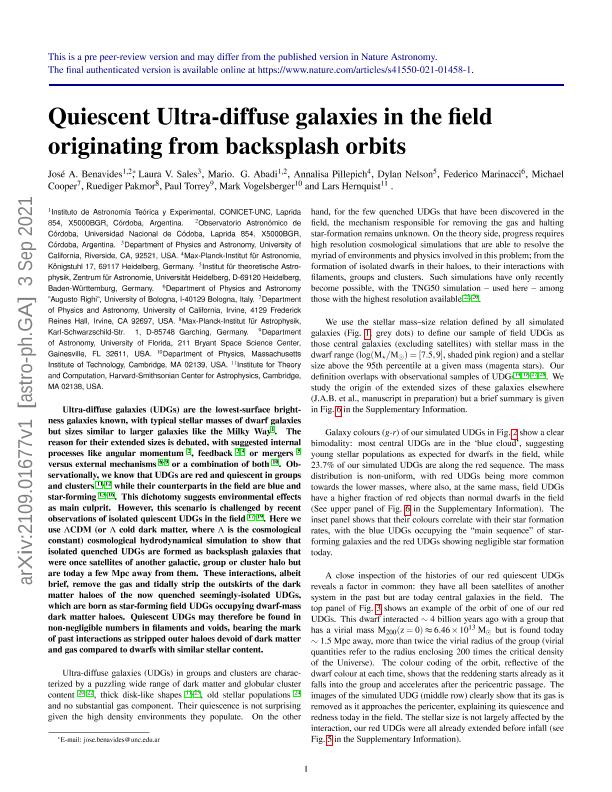Mostrar el registro sencillo del ítem
dc.contributor.author
Benavides Blanco, Jose Antonio

dc.contributor.author
Sales, Laura Virginia

dc.contributor.author
Abadi, Mario Gabriel

dc.contributor.author
Pillepich, Annalisa
dc.contributor.author
Nelson, Dylan
dc.contributor.author
Marinacci, Federico

dc.contributor.author
Cooper, Michael
dc.contributor.author
Pakmor, Ruediger
dc.contributor.author
Torrey, Paul
dc.contributor.author
Vogelsberger, Mark
dc.contributor.author
Hernquist, Lars
dc.date.available
2022-09-26T11:43:01Z
dc.date.issued
2021-12
dc.identifier.citation
Benavides Blanco, Jose Antonio; Sales, Laura Virginia; Abadi, Mario Gabriel; Pillepich, Annalisa; Nelson, Dylan; et al.; Quiescent ultra-diffuse galaxies in the field originating from backsplash orbits; Nature Publishing Group; Nature Astronomy; 5; 12; 12-2021; 1255-1260
dc.identifier.uri
http://hdl.handle.net/11336/170350
dc.description.abstract
Ultra-diffuse galaxies (UDGs) are the lowest-surface-brightness galaxies known, with typical stellar masses of dwarf galaxies but sizes similar to those of larger galaxies such as the Milky Way1. The reason for their extended sizes is debated, with suggested internal processes such as angular momentum2, feedback3,4 or mergers5 versus external mechanisms6–9 or a combination of both10. Observationally, we know that UDGs are red and quiescent in groups and clusters11,12 whereas their counterparts in the field are blue and star-forming13–16. This dichotomy suggests environmental effects as the main culprits. However, this scenario is challenged by recent observations of isolated quiescent UDGs in the field17–19. Here we use the ΛCDM (or Λ cold dark matter, where Λ is the cosmological constant) cosmological hydrodynamical simulation to show that isolated quenched UDGs are formed as backsplash galaxies that were once satellites of another galactic, group or cluster halo but are today a few Mpc away from them. These interactions, albeit brief, remove the gas and tidally strip the outskirts of the dark matter haloes of the now quenched and seemingly isolated UDGs, which are born as star-forming field UDGs occupying dwarf-mass dark matter haloes. Quiescent UDGs may therefore be found in non-negligible numbers in filaments and voids, bearing the mark of past interactions as stripped outer haloes devoid of dark matter and gas compared to dwarfs with similar stellar content.
dc.format
application/pdf
dc.language.iso
eng
dc.publisher
Nature Publishing Group

dc.rights
info:eu-repo/semantics/openAccess
dc.rights.uri
https://creativecommons.org/licenses/by-nc-sa/2.5/ar/
dc.subject
Ultra-diffuse galaxies
dc.subject
Backsplash orbits
dc.subject
Groups of galaxies
dc.subject
Galaxy interactions
dc.subject.classification
Astronomía

dc.subject.classification
Ciencias Físicas

dc.subject.classification
CIENCIAS NATURALES Y EXACTAS

dc.title
Quiescent ultra-diffuse galaxies in the field originating from backsplash orbits
dc.type
info:eu-repo/semantics/article
dc.type
info:ar-repo/semantics/artículo
dc.type
info:eu-repo/semantics/publishedVersion
dc.date.updated
2022-09-06T20:22:44Z
dc.identifier.eissn
2397-3366
dc.journal.volume
5
dc.journal.number
12
dc.journal.pagination
1255-1260
dc.journal.pais
Reino Unido

dc.journal.ciudad
Londres
dc.description.fil
Fil: Benavides Blanco, Jose Antonio. Consejo Nacional de Investigaciones Científicas y Técnicas. Centro Científico Tecnológico Conicet - Córdoba. Instituto de Astronomía Teórica y Experimental. Universidad Nacional de Córdoba. Observatorio Astronómico de Córdoba. Instituto de Astronomía Teórica y Experimental; Argentina
dc.description.fil
Fil: Sales, Laura Virginia. University of California; Estados Unidos
dc.description.fil
Fil: Abadi, Mario Gabriel. Consejo Nacional de Investigaciones Científicas y Técnicas. Centro Científico Tecnológico Conicet - Córdoba. Instituto de Astronomía Teórica y Experimental. Universidad Nacional de Córdoba. Observatorio Astronómico de Córdoba. Instituto de Astronomía Teórica y Experimental; Argentina
dc.description.fil
Fil: Pillepich, Annalisa. Gobierno de la República Federal de Alemania. Max Planck Institut für Astrophysik; Alemania
dc.description.fil
Fil: Nelson, Dylan. Gobierno de la República Federal de Alemania. Max Planck Institut für Astrophysik; Alemania
dc.description.fil
Fil: Marinacci, Federico. Universidad de Bologna; Italia
dc.description.fil
Fil: Cooper, Michael. University of California at Irvine; Estados Unidos
dc.description.fil
Fil: Pakmor, Ruediger. Gobierno de la República Federal de Alemania. Max Planck Institut für Astrophysik; Alemania
dc.description.fil
Fil: Torrey, Paul. University of Florida; Estados Unidos
dc.description.fil
Fil: Vogelsberger, Mark. Massachusetts Institute of Technology; Estados Unidos
dc.description.fil
Fil: Hernquist, Lars. Harvard-Smithsonian Center for Astrophysics; Estados Unidos
dc.journal.title
Nature Astronomy
dc.relation.alternativeid
info:eu-repo/semantics/altIdentifier/url/https://www.nature.com/articles/s41550-021-01458-1
dc.relation.alternativeid
info:eu-repo/semantics/altIdentifier/doi/http://dx.doi.org/10.1038/s41550-021-01458-1
Archivos asociados
